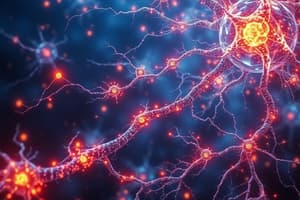Podcast
Questions and Answers
What is the primary function of neurotransmitters in the synaptic process?
What is the primary function of neurotransmitters in the synaptic process?
- To inhibit the release of synaptic vesicles from the terminal end
- To generate action potentials in the postsynaptic neuron
- To regulate the strength of synaptic connections
- To transmit signals across the synapse (correct)
Which part of the brain is responsible for regulating basic functions such as breathing, heart rate, and blood pressure?
Which part of the brain is responsible for regulating basic functions such as breathing, heart rate, and blood pressure?
- Brainstem (correct)
- Spinal cord
- Cerebrum
- Cerebellum
What type of neurons transmit information from the senses to the CNS?
What type of neurons transmit information from the senses to the CNS?
- Interneurons
- Motor neurons
- Sensory neurons (correct)
- Cerebellar neurons
What is the result of long-term depression (LTD) on synaptic connections?
What is the result of long-term depression (LTD) on synaptic connections?
What is the principle underlying Hebbian learning?
What is the principle underlying Hebbian learning?
What is the term for the electrical signal generated in the postsynaptic neuron in response to neurotransmitter binding?
What is the term for the electrical signal generated in the postsynaptic neuron in response to neurotransmitter binding?
Flashcards are hidden until you start studying
Study Notes
Neurotransmission
- Neurotransmitters: Chemical messengers released by neurons to transmit signals across synapses
- Examples: Acetylcholine, Dopamine, Serotonin, Norepinephrine
- Released from synaptic vesicles into the synapse
- Synaptic cleft: Small gap between the terminal end of one neuron and the dendrite of another
- Postsynaptic potential: Electrical signal generated in postsynaptic neuron in response to neurotransmitter binding
- Can be excitatory (EPSP) or inhibitory (IPSP)
Neuroanatomy
- Central Nervous System (CNS): Brain and spinal cord
- Cerebrum: Largest part of the brain, responsible for higher-order functions
- Cerebellum: Coordinates movement and balance
- Brainstem: Regulates basic functions (breathing, heart rate, blood pressure)
- Peripheral Nervous System (PNS): Nerves that connect CNS to the rest of the body
- Sensory neurons: Transmit information from senses to CNS
- Motor neurons: Transmit signals from CNS to muscles and glands
Synaptic Plasticity
- Long-term potentiation (LTP): Strengthening of synaptic connections based on experience
- Induced by high-frequency stimulation, increases synaptic strength
- Long-term depression (LTD): Weakening of synaptic connections based on experience
- Induced by low-frequency stimulation, decreases synaptic strength
- Hebbian learning: "Neurons that fire together, wire together"
- Synaptic plasticity based on correlated neural activity
Neurotransmission
- Neurotransmitters are chemical messengers released by neurons to transmit signals across synapses
- Examples of neurotransmitters include Acetylcholine, Dopamine, Serotonin, and Norepinephrine
- Neurotransmitters are released from synaptic vesicles into the synapse
- The synaptic cleft is the small gap between the terminal end of one neuron and the dendrite of another
- The synaptic cleft is where chemical neurotransmission takes place
- Postsynaptic potential is the electrical signal generated in the postsynaptic neuron in response to neurotransmitter binding
- Postsynaptic potential can be either excitatory (EPSP) or inhibitory (IPSP) depending on the type of neurotransmitter and receptor
Neuroanatomy
- The Central Nervous System (CNS) consists of the brain and spinal cord
- The CNS integrates and processes sensory information and generates responses
- The Cerebrum is the largest part of the brain, responsible for higher-order functions such as thought, emotion, and voluntary movement
- The Cerebellum coordinates movement and balance
- The Brainstem regulates basic functions such as breathing, heart rate, and blood pressure
- The Peripheral Nervous System (PNS) consists of nerves that connect the CNS to the rest of the body
- The PNS is divided into sensory neurons that transmit information from senses to the CNS and motor neurons that transmit signals from the CNS to muscles and glands
Synaptic Plasticity
- Long-term potentiation (LTP) is the strengthening of synaptic connections based on experience
- LTP is induced by high-frequency stimulation and increases synaptic strength
- LTP is an important mechanism for learning and memory formation
- Long-term depression (LTD) is the weakening of synaptic connections based on experience
- LTD is induced by low-frequency stimulation and decreases synaptic strength
- LTD is an important mechanism for forgetting and eliminating unnecessary neural connections
- Hebbian learning is the concept that "neurons that fire together, wire together"
- Hebbian learning is a form of synaptic plasticity based on correlated neural activity
Studying That Suits You
Use AI to generate personalized quizzes and flashcards to suit your learning preferences.




